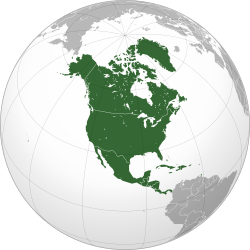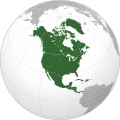Portal:North America
The North America Portal

North America is a continent in the Northern and Western hemispheres. North America is bordered to the north by the Arctic Ocean, to the east by the Atlantic Ocean, to the southeast by South America and the Caribbean Sea, and to the south and west by the Pacific Ocean. The region includes Middle America (comprising the Caribbean, Central America, and Mexico) and Northern America.
North America covers an area of about 24,709,000 square kilometers (9,540,000 square miles), representing approximately 16.5% of Earth's land area and 4.8% of its total surface area. It is the third-largest continent by size after Asia and Africa, and the fourth-largest continent by population after Asia, Africa, and Europe. As of 2021[update], North America's population was estimated as over 592 million people in 23 independent states, or about 7.5% of the world's population. In human geography, the terms "North America" and "North American" refers to Canada, Greenland, Mexico, Saint Pierre and Miquelon, and the United States.
It is unknown with certainty how and when first human populations first reached North America. People were known to live in the Americas at least 20,000 years ago, but various evidence points to possibly earlier dates. The Paleo-Indian period in North America followed the Last Glacial Period, and lasted until about 10,000 years ago when the Archaic period began. The classic stage followed the Archaic period, and lasted from approximately the 6th to 13th centuries. Beginning in 1000 AD, the Norse were the first Europeans to begin exploring and ultimately colonizing areas of North America.
In 1492, the exploratory voyages of Christopher Columbus led to a transatlantic exchange, including migrations of European settlers during the Age of Discovery and the early modern period. Present-day cultural and ethnic patterns reflect interactions between European colonists, indigenous peoples, enslaved Africans, immigrants from Europe, Asia, and descendants of these respective groups. (Full article...)
The Gettysburg Address is a speech delivered by Abraham Lincoln, the 16th U.S. president, following the Battle of Gettysburg during the American Civil War. The speech has come to be viewed as one of the most famous, enduring, and historically significant speeches in American history.
Lincoln delivered the speech on the afternoon of November 19, 1863, during a formal dedication of Soldiers' National Cemetery, now known as Gettysburg National Cemetery, on the grounds where the Battle of Gettysburg was fought four and a half months earlier, between July 1 and July 3, 1863, in Gettysburg, Pennsylvania. In the battle, Union army soldiers successfully repelled and defeated Confederate forces in what proved to be the Civil War's deadliest and most decisive battle, resulting in more than 50,000 Confederate and Union army casualties in a Union victory that altered the war's course in the Union's favor. (Full article...)

Charles Edward Magoon (December 5, 1861 – January 14, 1920) was an American lawyer, judge, diplomat, and administrator who is best remembered as a governor of the Panama Canal Zone; he also served as Minister to Panama at the same time. He was Provisional Governor of Cuba during the American occupation of Cuba from 1906 to 1909.
He was the subject of several scandals during his career. As a legal advisor working for the United States Department of War, he drafted recommendations and reports that were used by Congress and the executive branch in governing the United States' new territories following the Spanish–American War. These reports were collected as a published book in 1902, then considered the seminal work on the subject. During his time as a governor, Magoon worked to put these recommendations into practice. In summary: Magoon was hugely successful in Panama but criticized for his tenure in Cuba. (Full article...)

Potbelly sculptures (Spanish barrigones pl. or barrigón sing.) are in-the-round sculptures of obese human figures carved from boulders. They are a distinctive element of the sculptural tradition in the southern Maya area of Mesoamerica. The precise purpose of potbelly sculptures is unknown, although they appear to have been the focus of public veneration and ritual directed by the ruling elite. Although this sculptural tradition is found within the southern Maya area, it has been recognized that the sculptures themselves are non-Maya. (Full article...)
Did you know...
- ... that Confederate General John W. Frazer surrendered the Cumberland Gap during the American Civil War without a fight?
- ...that Castillo de los Tres Reyes Magos del Morro (pictured), a fortress which guards the entrance to Havana bay in Havana, was named after the biblical Magi?
- ...that the Soufrière Hills volcano is an active complex stratovolcano with many lava domes forming its summit on the Caribbean island of Montserrat?
- ... that Raul Macias, a Cuban-Mexican boxer parlayed his popularity into a successful career in telenovelas?
- ...that Jacob Piatt Dunn in 1886 wrote the first scholarly history concerning the Indian Wars?
Selected panorama

Topics
Categories
List articles
Related portals
Northern America
Central America
Caribbean
WikiProjects
 North America
North America-
 Canada
Canada -
 Greenland
Greenland -
 Mexico
Mexico -
 Saint Pierre and Miquelon
Saint Pierre and Miquelon -
 United States
United States  Central America
Central America-
 Belize
Belize -
 Costa Rica
Costa Rica -
 El Salvador
El Salvador -
 Guatemala
Guatemala -
 Honduras
Honduras -
 Nicaragua
Nicaragua -
 Panama
Panama  Mesoamerica
Mesoamerica Caribbean
Caribbean-
 Antigua and Barbuda
Antigua and Barbuda -
 Bahamas
Bahamas -
 Barbados
Barbados -
 Bermuda
Bermuda -
 Cuba
Cuba -
 Dominica
Dominica -
 Dominican Republic
Dominican Republic -
 Grenada
Grenada -
 Haiti
Haiti -
 Jamaica
Jamaica -
 Puerto Rico
Puerto Rico -
 Saint Kitts and Nevis
Saint Kitts and Nevis -
 Saint Lucia
Saint Lucia -
 Saint Vincent and the Grenadines
Saint Vincent and the Grenadines -
 Trinidad and Tobago
Trinidad and Tobago
Associated Wikimedia
The following Wikimedia Foundation sister projects provide more on this subject:
-
Commons
Free media repository -
Wikibooks
Free textbooks and manuals -
Wikidata
Free knowledge base -
Wikinews
Free-content news -
Wikiquote
Collection of quotations -
Wikisource
Free-content library -
Wikiversity
Free learning tools -
Wikivoyage
Free travel guide -
Wiktionary
Dictionary and thesaurus


















